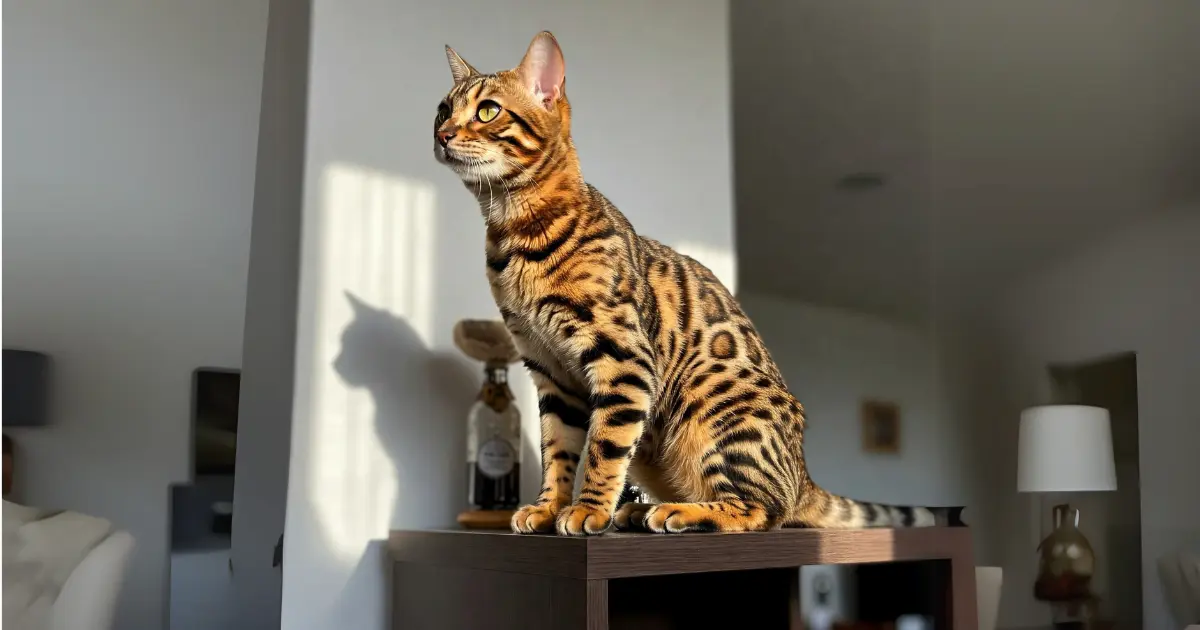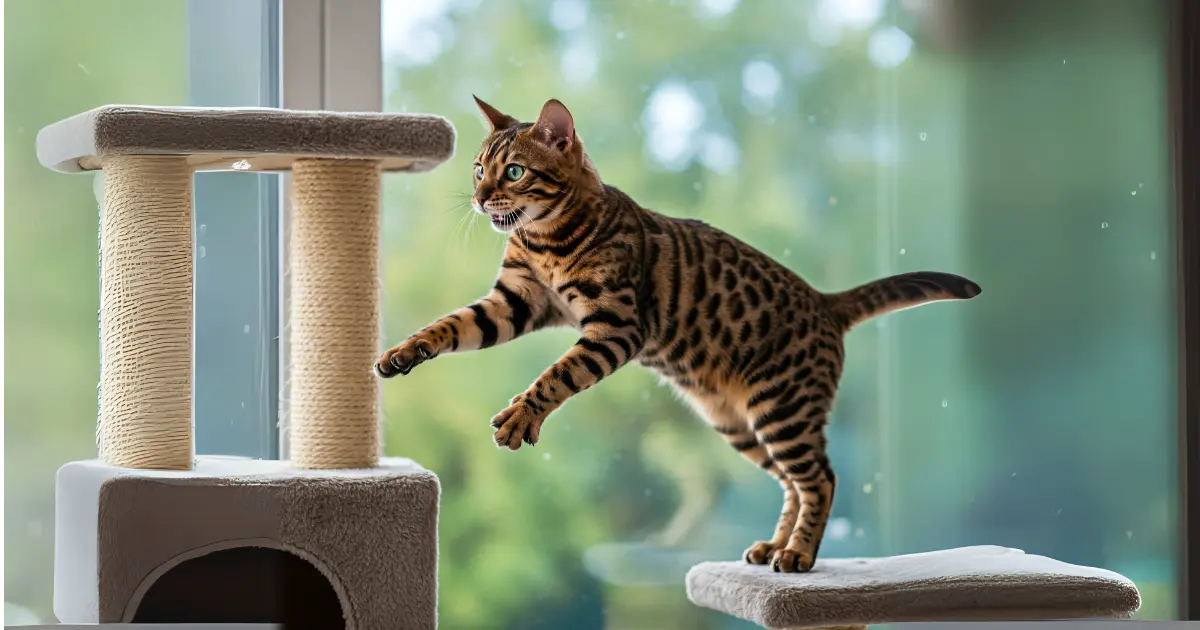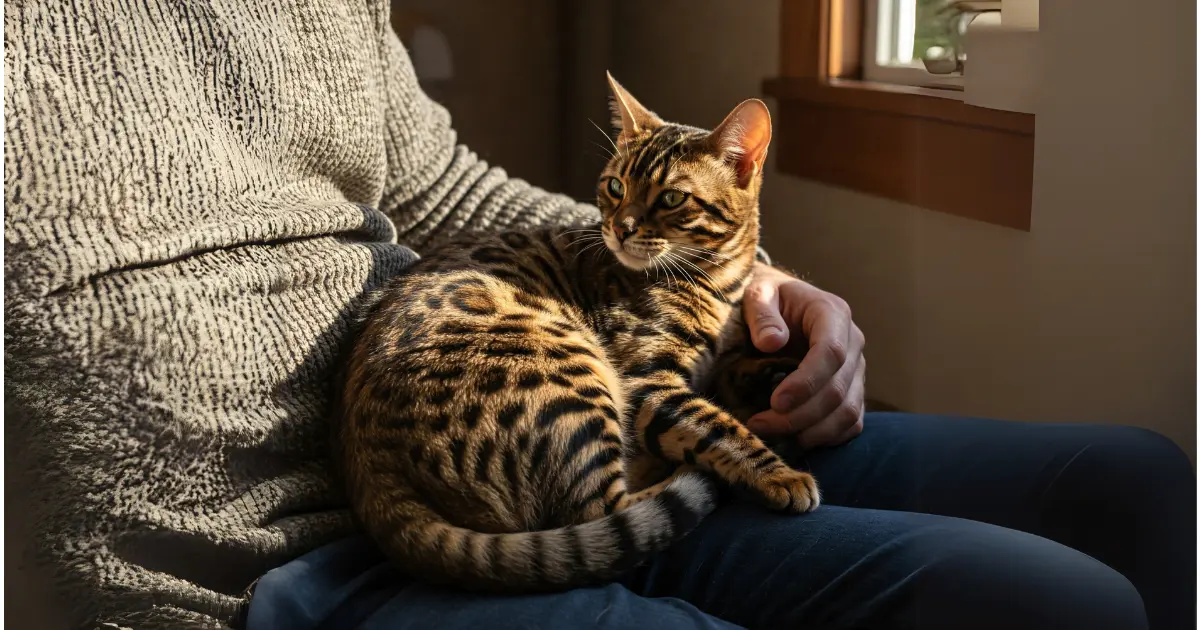Tabby Bengal Cat: The Wild Look with a Loving Heart
Published: 16 Feb 2025
If you’ve ever seen a cat that looks like it could belong in the jungle but acts like a total cuddle bug, you’ve probably encountered a Tabby Bengal cat. These cats are famous for their stunning appearance—spotted coats that remind you of wild leopards—but their personalities set them apart. Bengals aren’t just gorgeous and incredibly affectionate, full of energy, and surprisingly social. Let’s take a closer look at the world of the Tabby Bengal cat and see what makes them such a unique and lovable companion!

Table of Contents
Discovering the Tabby Bengal Cat?
A Tabby Bengal cat is a breed that turns heads wherever it goes. The combination of their sleek, muscular build and their exotic, wild-looking coats is what makes them stand out. Their coat comes in two main patterns: spotted and marbled, both inspired by their wild ancestor, the Asian Leopard Cat. They might look wild, but don’t let that fool you—Bengals are as affectionate as they are striking.
Physical Traits of a Tabby Bengal
- Coat: The coat is definitely what catches the eye first. Bengals wear a stunning, short jacket, almost like a work of art, with bold patterns that remind you of a wild leopard’s fur. You’ll see shades of gold, brown, and orange, each cat having unique markings—some with spots that look like they were painted on, others with beautiful marbled swirls. You can’t help but be captivated by their distinctive look—each Bengal seems to have its unique charm that’s hard to look away from.
- Build: Bengal cats are muscular yet graceful. Their firm, athletic frame lets them jump, run, and easily play. Their medium to large size makes them look even more majestic.
- Eyes: Their eyes are one of their most captivating features. Large, almond-shaped, and often a deep golden or green color, their eyes are almost hypnotic.
Unsurprisingly, people are drawn to their wild beauty, but their personality wins people over.

The Fascinating History of the Tabby Bengal
Bengals didn’t just appear out of nowhere—they result from a carefully planned breeding program. The breed was created in the 1980s when breeders began crossing domestic cats with the wild Asian Leopard Cat, aiming to bring the beauty of the wild into the world of house cats from Southeast Asia. The idea was to create a domestic cat that looked like a wild leopard but with a more docile, friendly nature. A related hybrid breed, the Savannah Bengal Mix, also shares wild ancestry and makes for an equally fascinating companion.
Over time, breeders focused on bringing out the best of both worlds—exotic beauty and a loving, playful temperament. With its distinctive coat patterns, the Tabby Bengal emerged due to this careful breeding. Today, Bengals are recognized for their striking appearance and affectionate behavior.
What Are Bengals Like as Pets?
Bengals may have wild looks, but their personalities are about affection and energy. Here’s what you can expect if you’re thinking of adopting one:
Affectionate and Social
Despite their wild ancestry, Bengals are super social. They’re not the type of cat that sits quietly in the corner; they’ll actively seek you out, follow you from room to room, and be ready to cuddle when you least expect it. They form strong, deep bonds with their humans, and many owners describe Bengals as “dog-like” because they seek attention and interaction.
Personal anecdote: One of my friends has a Bengal, and every time I visit, it’s like the cat knows I’m there before I even walk in the door. The cat will come rushing over, purring loudly, and jump onto my lap. It’s like a full-on welcome party every time!

Energetic and Playful
Bengals are high-energy cats. If you’re looking for a calm lap cat, Bengals are probably not the right choice. They’re always on the move, leaping, running, and exploring. Their natural curiosity drives them to keep moving and finding new things to do. They love toys, and the more interactive, the better.
Give them spaces to climb and explore to keep them engaged and happy. Bengals love cat trees, shelves, and anything they can scale.
Intelligent and Inquisitive
Bengals are some of the most intelligent cats around. They’re quick learners and love to solve problems. If you’ve got a puzzle feeder or a toy that requires them to think, you’ll see how quickly they catch on. They’ll also get bored easily, so you’ll need to keep their brains active just as much as their bodies.
Personal story: I watched a Bengal figure out how to open a drawer in less than a minute. No joke—this cat was in there so fast that I had to laugh. They’re clever little escape artists, so make sure your house is Bengal-proof!
How to Care for Your Tabby Bengal
So, what’s it like to take care of a Tabby Bengal? They’re low-maintenance in some ways but high-maintenance in others. If you’re looking for a cat that doesn’t require as much attention, consider exploring our guide on Low-maintenance Cat Breeds for other options. Here’s how to keep your Bengal happy and healthy.
Grooming
Bengals have short coats, which means they’re relatively low-maintenance when grooming. You won’t have to worry about tangles or mats, but weekly brushing helps keep their coat shiny and removes loose hair. They shed, but it’s not nearly as much as some long-haired breeds.
Staying Active
Bengals aren’t just indoor cats. They need regular play and mental stimulation to stay healthy. They might become a bit destructive if you’re not ready to give them lots of attention and exercise. They need space to run, jump, and explore, so if you don’t have a big house, invest in cat furniture like climbing trees and scratching posts.
Make playtime a part of your daily routine. You don’t have to spend hours, but even 15–20 minutes of interactive play each day will make a huge difference in their happiness.
Feeding
Because Bengals are so active, they need high-quality, high-protein food to keep their energy up. Look for foods where meat is the first ingredient—whether it’s chicken, turkey, or fish. Avoid food with too many fillers, like corn or soy.
If you want your Bengal to thrive, feed them food designed for active breeds, like Wellness CORE or Orijen. It’s worth the investment for their health.
Health Concerns for Tabby Bengals
While Bengals are generally healthy, there are a few conditions that you should be aware of. Let’s look at what could come up and how to address it.
Hip Dysplasia
Bengals can sometimes experience hip dysplasia, a condition where the hip joint doesn’t develop as it should, causing pain and making movement challenging. This is more common in larger breeds, so keeping a close eye on your Bengal’s mobility and ensuring they’re comfortable moving around is essential.
Keeping your Bengals at a healthy weight and ensuring they get a lot of exercise helps support their joints. If you notice limping or stiffness, visit your vet.
Heart Disease
Bengals are also prone to hypertrophic cardiomyopathy (HCM), a heart condition where the heart muscles thicken, which can eventually lead to heart failure. Regular vet check-up are essential for early detection.
Annual check-ups, including heart screenings, are highly recommended for Bengals to keep any potential heart issues in check.
Eye Issues
Bengals can sometimes develop eye issues, including cataracts or retinal problems. It’s essential to watch for signs of vision changes, like bumping into objects or appearing more “clumsy” than usual.

Is a Tabby Bengal Right for You?
Before deciding, consider the benefits and challenges of bringing a Bengal into your home.
Pros of Owning a Tabby Bengal
- Beautiful appearance: Bengals are show-stoppers. Their wild looks are mesmerizing, and they’re always getting attention!
- Loyal and affectionate: Once you’ve gained a Bengal’s trust, they’re incredibly loving and always want to be around you.
- Playful nature: If you love active cats that are up for anything, Bengals are your match.
Cons of Owning a Tabby Bengal
- High energy: Bengals need lots of stimulation. If you don’t have time for daily play sessions, this might not be the breed for you.
- Not a couch potato: They’re not the type to sit on your lap for hours. They need mental and physical exercise.
Conclusion: Should You Adopt a Tabby Bengal?
If you’re looking for a cat full of energy, playfulness, and love—one with the wild look of a jungle cat but the heart of a loyal friend—the Tabby Bengal might be the perfect match. They’ll keep you on your toes with their spirited nature, but in return, they’ll shower you with endless affection and bring plenty of fun into your life. Learn more about the Bengal cat breed and its history on The International Cat Association’s (TICA) official website.
So, are you ready to welcome a Bengal into your home? With the proper care and attention, you’ll have a loving companion by your side for many years.
Frequently Asked Questions (FAQs)
Are Tabby Bengals good with children?
Yes, Bengals are generally excellent with children, especially if they’ve been socialized early. Their playful and curious nature makes them great companions for families.
Do Tabby Bengals need a lot of grooming?
Not really. Bengals have short coats that don’t mat or tangle, so grooming is minimal. Regular brushing helps, especially during the shedding season
Do Tabby Bengals like playing with water?
Many Bengals find water fascinating, often splashing in sinks or jumping into showers. Their wild instincts make them more curious about water than most domestic cats, but it varies between individuals.
Are Tabby Bengals easy for beginners to care for?
While Bengals are affectionate and engaging, they require high activity and attention. Beginners should be prepared for their playful, sometimes demanding nature, as they thrive on interaction and mental stimulation.
How much exercise do Tabby Bengals need each day?
Bengals are full of energy and need a lot of playtime to stay happy and healthy. A few hours of active play, including climbing and problem-solving, are essential to prevent boredom.
Can Tabby Bengals adapt to being alone for long hours?
Bengals aren’t the best choice for people who are away from home frequently. They are social cats that thrive on companionship, and long periods of solitude may lead to anxiety or destructive behavior.
Are Tabby Bengals prone to any specific health conditions?
Bengals can sometimes develop heart issues like hypertrophic cardiomyopathy (HCM) or joint problems like hip dysplasia. Regular vet visits are essential to catch any potential health concerns early.
How often do Tabby Bengals need grooming?
Thanks to their short, sleek coats, Bengals don’t require much grooming. However, regular brushing helps remove loose hair and keeps their coat glossy, especially during shedding seasons.
How do Tabby Bengals interact with other cats?
Bengals are typically social and can get along well with other cats, especially if introduced properly. Their energetic nature might make them appear overwhelming to shy cats, so patience and careful introductions are key.

- Be Respectful
- Stay Relevant
- Stay Positive
- True Feedback
- Encourage Discussion
- Avoid Spamming
- No Fake News
- Don't Copy-Paste
- No Personal Attacks



- Be Respectful
- Stay Relevant
- Stay Positive
- True Feedback
- Encourage Discussion
- Avoid Spamming
- No Fake News
- Don't Copy-Paste
- No Personal Attacks





